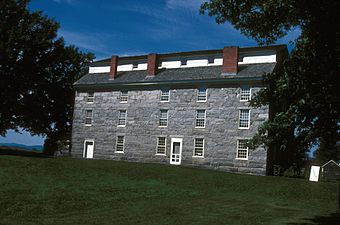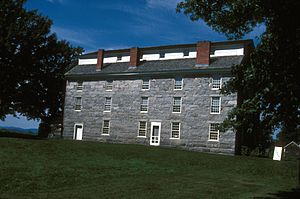Brownington Village Historic District facts for kids
Quick facts for kids |
|
|
Brownington Village Historic District
|
|

Athenian Hall
|
|
| Location | Hinman Settler Road and Brownington Center Road, Brownington, Vermont |
|---|---|
| Area | 110 acres (45 ha) |
| Architectural style | Greek Revival |
| NRHP reference No. | 73000197 |
| Added to NRHP | May 9, 1973 |
The Brownington Village Historic District is a special historical area in Brownington, Vermont. It is located where Hinman Settler Road and Brownington Center Road meet. This district was added to the National Register of Historic Places on June 9, 1973. It includes five buildings that are part of the Old Stone House Museum complex. There are also three other old houses nearby. All these buildings date back to the early 1800s.
Contents
- A Look Back: Brownington's Early Days
- The Old Stone House: Athenian Hall
- Alexander Twilight's Home
- The Lawrence Barn
- Museum Education Center
- The Cyrus Eaton House
- Samuel Read Hall House
- Brownington Church and Cemetery
- Prospect Hill and Observatory Tower
- Rice and Going Hotel
- Orleans County Grammar School
- See also
A Look Back: Brownington's Early Days
In the early 1800s, Brownington was a very important town. It was located on the Hinman Settler Road. This road was a main route in the county. It was also a stop for stagecoaches traveling from Boston, Massachusetts to Montreal, Quebec, Canada. Before 1816, Brownington was one of two county seats. This meant it was a center for local government. People built many facilities to make the most of the town's good location.
The Old Stone House: Athenian Hall
This amazing four-story building was built by Alexander Twilight himself. He used granite, which was very unusual for buildings in Orleans County back then. No one knows where he got all the granite. Twilight called it "Athenian Hall." It was a dormitory for students who came from out of town. These students attended the Orleans County Grammar School nearby.
The dormitory closed in 1859, two years after Twilight passed away. In 1918, the Orleans County Historical Society bought the building for $500. Today, it is known as "The Old Stone House Museum." It is one of the best-preserved old institutional buildings in the United States. The museum shows collections of furniture, paintings, and tools from the 1700s, 1800s, and early 1900s.
Alexander Twilight's Home
Right across the road from the Old Stone House is Alexander Twilight's own house. He built this house in 1830. Mr. Twilight and his wife welcomed several students to live with them each year. These students slept in rooms on the second floor. Students continued to board with the Twilights even after Athenian Hall was built. The Orleans County Historical Society bought this house in 1999. It has been carefully restored. Now, it serves as a visitor center for the Museum. It is also the office for the Historical Society.
The Lawrence Barn
This barn is an English-style barn. It was built during the first half of the 1800s. It looks similar to the barn that was originally next to the Twilight House. This barn was moved to its current spot in 1997. Inside, you can find an exhibit. It shows how farming has changed in Orleans County over two centuries.
Museum Education Center
This building was likely the first house on the land where the Alexander Twilight House now stands. It was given to the Museum in 1978. Today, it is used as an education center. Here, visitors can learn more about the history of the area.
The Cyrus Eaton House
Cyrus Eaton, a friend of Alexander Twilight, built this house in 1834. Its style is late Federal, but it was later updated with some Greek Revival features. The building has been fully restored. This includes its cedar shake roof. It now holds the archives and research collections of the Historical Society. Behind the house, there is a beautiful perennial garden. This garden was started in the mid-1800s.
Samuel Read Hall House
George West built this house in 1831. It was built in the Federal style. For 21 years, this house was the home of Samuel Read Hall. He was a teacher at the Orleans County Grammar School. The Historical Society bought the Samuel Read Hall House in 2006. It is currently being restored to its original condition.
Brownington Church and Cemetery
The Brownington Congregational Church was finished in 1841. Both Alexander Twilight and Samuel Read Hall served as ministers there. In 1899, William Barstow Strong paid for major changes to the church's inside. Strong grew up in Brownington and went to the Orleans County Grammar School. He also paid for a new bell and spire for the church's bell tower.
Prospect Hill and Observatory Tower
When the grammar school classrooms were nearby, students would climb this hill. They went there for evening vespers, which are evening prayers. In 1898, William Barstow Strong built an observatory at the top of the hill. This observatory was rebuilt in 1975 by the Grange. This was done for the national bicentennial celebration. It was rebuilt again in 1998.
Rice and Going Hotel
This farmhouse was built in 1815. It used to operate as a hotel. Today, it is a privately owned home.
Orleans County Grammar School
William Baxter paid for this building to be constructed in 1823. It was built at the bottom of Prospect Hill. In 1869, the building was moved about one-third of a mile down the road. The town of Brownington owned the building. It was also used by the Grange, a community organization.
In 2016, the school building was moved again. It was placed west of the church, closer to the Historic District. To move it, 44 oxen were hitched to the building. This was done to show how buildings were moved in the 1800s.
See also




